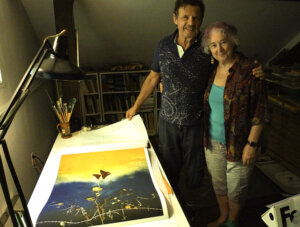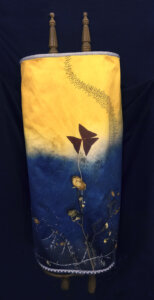Birds, barbed wire, darkness and sunlight — the artistic challenge of making a Torah mantle for a Holocaust scroll
Jerri Zbiral wanted to create a Torah mantle that would make an artistic statement while also commemorating history

The creation of a new Torah mantle involved the use of new technology, and a good deal of soul-searching about art, life, memory and Judaism. Courtesy of Alan Teller
When I was a kid growing up in New York City in the 1950s, Torah mantles, the cloth covering that protects the Torah, were blue velvet with gold trim. Occasionally, there was a lion, and there was usually some statement honoring someone’s bar mitzvah or wedding or their role in the shul. The mantles were respectful, but aesthetically boring. Sometime later, possibly with the cultural upheaval of the ‘60s, creativity crept into the design . And when my wife, the artist Jerri Zbiral, was asked to create a new mantle for a very special Torah, she jumped at the chance.
Jerri was born in Prague a few years after the war. Though her family was not Jewish, her mother’s first husband was killed by the Nazis during the total destruction of the Catholic Czech village of Lidice. Ostensibly in retaliation for the assassination of Reinhard Heydrich — the man who thought up the “Final Solution” — this tragedy broadcast the Nazi’s cruelty to the world.
Jerri’s mother Anna spent three years in the Ravensbrück concentration camp. Jerri’s half-sister Eva was spirited away through the efforts of a courageous aunt and was one of the few children who survived the massacre. Anna also lived and reunited with Eva at war’s end. She eventually remarried, gave birth to Jerri, and fled the country with her new husband when the Communists took over. They first went to a refugee camp (ironically in Germany) then to Norway before settling in Montreal. Many years later, Jerri converted to Judaism. When our synagogue in Evanston, Illinois, acquired a “Holocaust Scroll” from Prague, she was the logical choice to design a new mantle.
A bit of history
The Nazis marched into Prague in 1939, six months after the Munich pact ceded the Sudetenland in northern Czechoslovakia to Germany. By war’s end in 1945, only 14,000 Jews had survived a bloody occupation that saw over a quarter of a million Czech Jews murdered. During the war, the Nazis had ordered that all ceremonial objects, including Torahs, be sent to the Jewish Museum in Prague where Jewish curators carefully catalogued each one. 1,564 scrolls survived the war. Most of the curators who saved them did not.
After the war, the scrolls were moved to an unused synagogue/warehouse on the outskirts of Prague. They were piled high in abysmal storage conditions where they lay, quietly deteriorating, until 1963. Then, the Czech government approached a London art dealer to see if he might have a buyer. Ralph Yablon, a lawyer and philanthropist, purchased all of the scrolls and had them shipped to the Westminster Synagogue in London. Eventually, the Memorial Scrolls Trust was formed to oversee the authenticity, conservation and distribution of these sacred survivors. One of these scrolls, #1443, was sent on permanent loan to Temple Judea Mizpah in Skokie, Illinois.

In 2018, TJM merged with Beth Emet Synagogue in nearby Evanston, where Jerri and I are members, providing our shul with its own Holocaust Torah. David and Sharon Kessler, former members of TJM, spearheaded an effort to tell its story:
“David and I wanted to honor this scroll which had been a living part of the Pinkas Synagogue in Prague until the Holocaust,” Sharon Kessler said. “The new mantle needed to reflect her history, which is all of our history too. We did not know what it needed to look like. That was when my new friend, Jerri Zbiral stepped up and volunteered to design, create and make a mantle.”
This began a process that took many months. Ultimately, it involved our entire family, the use of new technology, and a good deal of soul-searching about art, life, memory and Judaism.
I asked Jerri why she wanted to do this and what this Torah from Prague might mean to her.
“I didn’t convert until relatively recently but have lived a Jewish life since our marriage,” she said. “I still have a strong connection to being Czech and to Prague in particular. My family legacy was non-Jewish; they were in the wrong place at the wrong time and paid the price. For me, this was an opportunity to give back to the community that adopted me, a chance to honor my Czech heritage within a Jewish context.
Jerri’s embrace of Judaism included a belief that the Torah must be treated with respect. “The fact that they were just thrown in a warehouse made me sick,” she said. “This Torah was part of my country although not initially my culture. And here’s a piece of my homeland at my synagogue, in my community. Of course I wanted to be involved.”
Jerri had previously repaired an old mantle for the synagogue and had also sewn together a new covering for one of our shul’s Torahs, a beautiful, abstract, woven fabric piece created by another congregant. But this was the first time she would be conceiving and creating an entirely new one — and one with a direct connection to her family history.
How to design a Torah mantle
Several years earlier, we had created a unique chuppah for our son Max’s wedding. We had scanned old photographs from both families, created a montage, and had the resulting image printed on cloth. The result was that Max and Priya were wed under the gaze of all their ancestors. While such a photographic process had never before been used to craft a Torah mantle, it seemed possible.
At first, Jerri struggled with photographs of the Holocaust; dark, disturbing representations of gloomy people marching to an unknown destiny, ravens and vultures perched on scorched barren trees, lots of barbed wire. Ultimately, none of this fit with her evolving vision. Also, Torah mantle designs tend to be symbolic, rather than clearly representational — and certainly not based on documentary photographs from the worst period in Jewish history. One day, when she felt particularly stuck creatively, Max called and asked her what she hoped people would walk away with when they saw the mantle. That simple question took her away from other people’s images and freed her to create her own.

Jerri knew that she wanted a background that faded gently from darkness to light, from a dark blue that slowly morphed into bright, yellow sunlight. We found a file online and I made a full-size print. Then she began to carefully place objects directly on the print: barbed wire; dead branches and a dried red rose as a centerpiece. As we were looking at the work-in-progress, not satisfied with the red rose, our daughter Emma suggested a yellow rose that she happened to have. It made a difference. But something still didn’t look right.
“The next day, I happened to glance over at Priya’s beautiful Oxalis Triangularis plant that I was babysitting and here was the life form I was looking for — light, airy, fluffy, almost alive,” Jerri said.
She also knew that she wanted birds, a swoosh of birds, birds that were alive, happy and free. Years earlier, we had met Peter Sís, the MacArthur Fellow who was a Czech refugee and immigrant artist, like Jerri herself, and had written and illustrated The Conference of the Birds, with just the type of imagery that Jerri envisioned. She reached out to him.
Sis’ most-recent book, Nicky & Vera, told the story of Nicholas Winton, who in 1939 saved the lives of some 700 Czech Jewish children by arranging their escape to England. She asked Peter if he would draw birds for our Torah mantle. He said he would be honored. I photographed and printed to size the layout Jerri had created and we drove to see Peter, just outside of New York City. We left him several prints to work with and within a few weeks, he sent us what would become the centerpiece of the new mantle.
The next step was to have this photographic print, enhanced with Sís’ drawing, scanned at extremely high resolution and converted to a very large digital file which could be printed on cloth. In my professional life as a photographer and museum exhibit curator and designer, I often worked with a master printer, John Greusel. He was eager to undertake the challenge. We examined several different fabrics before selecting one that would hold the quality of the piece. Then, once this beautiful image was successfully printed on cloth, it needed to be sewn together.
“And who taught me to sew?” asked Jerri. “My mother. And what was she forced to do in the concentration camp? She sewed uniforms for the damn Nazis. As a child, I refused to let her teach me to sew, but watching her day in and day out at the sewing machine, I knew how to sew. It was in my DNA. So I knew how to make art and I knew how to sew and I knew whether something worked design-wise or not.”
Ultimately, Jerri did answer Max’s question — what she hoped people would walk away with when they saw the mantle. She wants people, viewing the mantle at a distance, to see a progression from the heavy darkness of the Holocaust to birds soaring into the light of a bright sky and through that symbolism to know that love, hope and lightness are possible. Getting closer to the Torah, she wants people to see the details in its covering and think about what all the symbols mean, to ask themselves what it means to be free. This Torah has traveled so far, witnessing hatred and cruelty, but it has survived.
We venerate any Torah for the words it contains and the meanings we derive from interpreting them. But ones that have a history add another layer, connoting a meaning far beyond physical components. Jerri wants those who take the time to really see the mantle to have an emotional response, one that will help lighten their souls and, in the process, lighten her own as well. Given the recent trauma, echoing the horrors of the past, that message is needed now more than ever.
A message from our Publisher & CEO Rachel Fishman Feddersen

I hope you appreciated this article. Before you go, I’d like to ask you to please support the Forward’s award-winning, nonprofit journalism so that we can be prepared for whatever news 2025 brings.
At a time when other newsrooms are closing or cutting back, the Forward has removed its paywall and invested additional resources to report on the ground from Israel and around the U.S. on the impact of the war, rising antisemitism and polarized discourse.
Readers like you make it all possible. Support our work by becoming a Forward Member and connect with our journalism and your community.
— Rachel Fishman Feddersen, Publisher and CEO





























